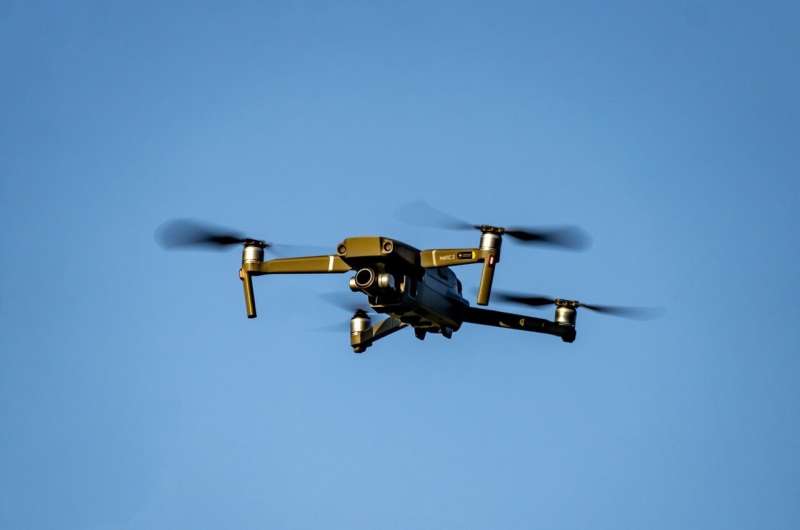Agricultural drones are taking off globally, saving farmers time and money

Gaby Clark
scientific editor

Andrew Zinin
lead editor

Drones have become integrated into everyday life over the past decade—in sectors as diverse as , and . They have also begun to transform the way people grow food.
In a new study published in the journal Science, we show that use of agricultural drones has . In as social scientists studying agriculture and rural development, we set out to document where agricultural drones have taken off around the world, what they are doing, and why they have traveled so far so fast. We also explored what these changes mean for farmers, the environment, the public and governments.
From toys to farm tools
Just a few years ago, agricultural drones were expensive, small and difficult to use, limiting their appeal to farmers. In contrast, today's models can be flown immediately after purchase and (100 kg)—the weight of two sacks of fertilizer.
Their prices vary from country to country due to taxes, tariffs and shipping costs. In the U.S., a drone owner can expect to spend for the same equipment that a farmer in China could buy for less than . However, , small businesses that supply drones and pilots for a fee, making them easy and relatively affordable to use.
Agricultural drones are now akin to flying tractors—multifunctional machines that can perform numerous tasks using different hardware attachments. Common uses for drones on farms include spraying crops, spreading fertilizer, sowing seeds, transporting produce, dispensing , painting greenhouses, , mapping field topography and drainage, and . This versatility makes drones valuable for growing numerous crops, on farms of all sizes.
Technological leapfrogging
We estimated the number of agricultural drones operating in some of the world's leading agricultural countries by scouring online news and trade publications in many different languages. This effort revealed where agricultural drones have already taken off around the world.
Historically, most agricultural technology—tractors, for example—has spread from . Drones partially reversed and dramatically accelerated this pattern, diffusing first from East Asia to Southeast Asia, then to Latin America, and finally to North America and Europe. Their use in higher-income regions is more limited but is accelerating rapidly in the U.S.
China leads the world in agricultural drone manufacturing and adoption. In 2016, a Chinese company introduced the . There are now agricultural drones reported to be in use there. Other middle-income countries have also been enthusiastic adopters. For instance, drones were used on in 2023, up from almost none in 2019, mainly by spraying pesticides and spreading fertilizers.
In the U.S., the number of leaped from about 1,000 in January 2024 to around 5,500 in mid-2025. suggest those numbers substantially underreport U.S. drone use because some owners seek to avoid the complex registration process. Agricultural drones in the U.S. are used mainly for spraying crops such as corn and soy, especially in areas that are difficult to reach with tractors or crop-dusting aircraft.
Safer, but not risk-free
In countries such as China, Thailand and Vietnam, millions of smallholder farmers have upgraded from the dangerous and tiring job of applying agrochemicals by hand with backpack sprayers to using some of the most cutting-edge technology in the world, often .
Shifting from applying chemicals with backpack sprayers to drones substantially .
However, because drones usually spray from , if used improperly, they can to neighboring farms, waterways or bystanders. That can damage crops and endanger people and nature.
Saving labor or displacing it?
Drones save farmers time and money. They reduce the need for smallholders—people who farm less than 5 acres (2 hectares), which account for —to do dangerous and tiring manual spraying and spreading work on their own farms. They also remove the need to hire workers to do the same.
By eliminating some of the last remaining physically demanding work in farming, drones may also help make agriculture more attractive to rural youth, who are often disillusioned with the . In addition, drones create new skilled employment opportunities in rural areas for pilots, .
On the downside, using drones could displace workers who currently earn a living from crop spraying. For instance, according to , drones can cover between 10 and 25 acres (4 to 10 hectares) of farmland per hour when spraying pesticides. That is equivalent to the effort of between 30 and 100 workers spraying manually. Governments may need to find ways to help displaced workers find new jobs.
Sky's the limit
Drones spray and spread fertilizers and seeds , so that less is wasted. They may also and than large farm machines such as tractors.
In combination, these factors may increase the amount of food that can be produced on each acre of land, while reducing the amount of resources needed to do so. This outcome is a holy grail for agricultural scientists, who refer to it as "."
However, much of the evidence so far on yield gains from drone-assisted farming is anecdotal, or based on small studies or .
The drone revolution is reshaping farming faster than almost any technology before it. In just five years, millions of farmers around the world have embraced drones. Early signs point to big benefits: greater efficiency, safer working conditions and improved rural livelihoods. But the full picture isn't clear yet.
More information: Ben Belton et al, Can the global drone revolution make agriculture more sustainable?, Science (2025).
Journal information: Science
Provided by The Conversation
This article is republished from under a Creative Commons license. Read the .![]()


















